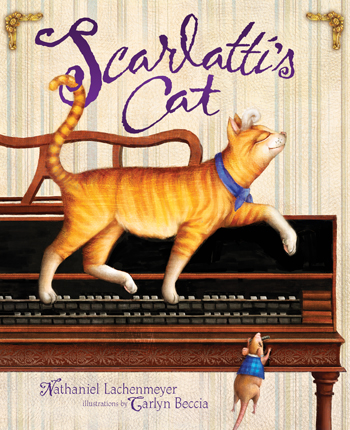| Scarlatti's cat Author: Lachenmeyer, Nathaniel | ||
| Price: $6.50 | ||
Summary:
Reveals how Pulcinella, a cat, contributed to one of the most popular symphonies written by eighteenth-century composer Domenico Scarlatti, and the consequences for the pampered pet.
| Illustrator: | Beccia, Carlyn |
| Accelerated Reader Information: Interest Level: LG Reading Level: 3.70 Points: .5 Quiz: 162759 | Reading Counts Information: Interest Level: K-2 Reading Level: 3.20 Points: 1.0 Quiz: 63352 | |
Reviews:
Kirkus Reviews (-) (01/15/14)
School Library Journal (02/01/14)
Booklist (03/15/14)
Full Text Reviews:
School Library Journal - 02/01/2014 K-Gr 2—According to legend, Domenico Scarlatti's Sonata in G Minor (generally known as the "Cat's Fugue") was inspired by the composer's cat. This book tells the rest of the story. Pulcinella loves to listen to Scarlatti play his harpsichord, but what she really wants is to compose her own music. However, she never breaks his strict house rule-no one is allowed to touch his harpsichord. Then one day she spots a mouse in the music room and gives chase. The wild romp ends with Pulcinella falling from the drapes onto the harpsichord. She cannot resist the opportunity to play the music she hears in her dreams, and the astonished man writes down every note. His amazement turns to dismay as he wonders what will happen if word gets out that his cat is as good a composer as he is, so he gives her to the painter Louis-Michel van Loo, who, coincidentally, begins painting his greatest works soon after. Scarlatti gives Pulcinella as much credit for the music as he dares by telling people that he was inspired by his pet walking on his harpsichord keys when he wrote it. Beccia's painterly illustrations are evocative of the time period and have muted colors, plenty of detail, and a little whimsy thrown in for good measure, as when the mouse sports a lovely vest and plays a flute and Pulcinella has a 18th-century coif on her head. A fun historical read that could be used as a segue to discussing composers and artists or read simply as an amusing cat tale.—Catherine Callegari, Gay-Kimball Library, Troy, NH - Copyright 2014 Publishers Weekly, Library Journal and/or School Library Journal used with permission.
Booklist - 03/15/2014 Artists get their creative inspirations from a variety of places, and in the case of Domenico Scarlatti, an Italian composer, it is his orange tabby cat. While Scarlatti composes on his harpsichord, his cat, Pulcinella, longs to create her own tunes. However, since the composer has a rule that no one can play the musical instrument except the maestro himself, the feline must content herself with her dreams. That is, until the day a mouse disrupts the household and Pulcinella ends up jumping on the harpsichord and revealing her extensive talent. Musical measures and notes decorate the rich, full-color digital illustrations, which closely resemble oil paintings. A subtle crackly finish enhances the impression of old artwork. Tess Weaver’s Opera Cat (2002), the story of a cat that sings operettas, would be a complementary title, bringing together two appealing tales of cats and music. - Copyright 2014 Booklist.



